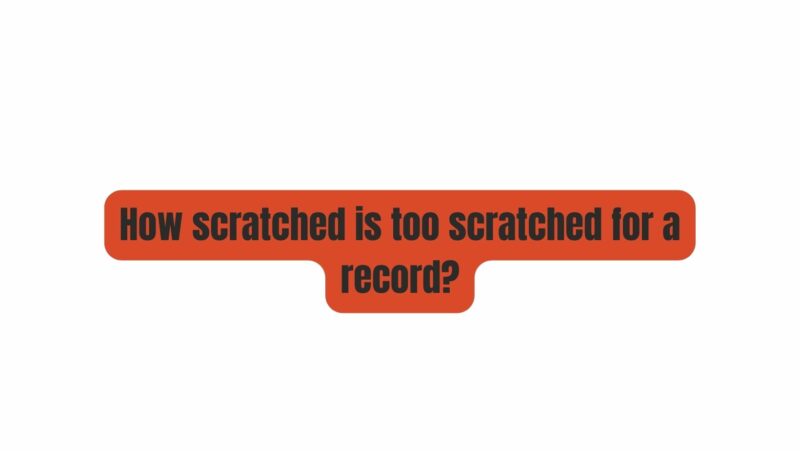Vinyl records have experienced a remarkable resurgence in recent years, with music enthusiasts and audiophiles alike drawn to the warm, analog sound that only vinyl can provide. However, one enduring challenge that vinyl collectors face is the issue of scratches and their impact on sound quality. In this article, we will delve into the world of scratches on vinyl records, exploring how scratches occur, the different types of scratches, their effects on sound quality, and tips on prevention and restoration.
Understanding Vinyl Records and Their Vulnerability
Vinyl records consist of grooves that are meticulously etched with audio information. When a stylus or needle is placed on these grooves, it traces the contours, translating them into sound. While this analog technology delivers exceptional audio quality, it is also susceptible to damage, particularly scratches. Scratches disrupt the smooth flow of the stylus, causing unwanted noise, distortion, and even permanent damage to the record.
The Anatomy of Scratches
- Surface Scratches: These are shallow scratches that generally occur on the surface of the record. They are often the result of mishandling or improper storage. Surface scratches tend to be less damaging to the overall sound quality and can sometimes be overlooked during playback.
- Deep Scratches: Deeper scratches are more problematic. These penetrate the grooves where the audio information is stored, leading to audible pops, clicks, and distortion. Deep scratches can significantly degrade the listening experience and may necessitate restoration.
- Cracks and Chips: In extreme cases, records can develop cracks or chips. These are detrimental to both sound quality and the structural integrity of the record. Cracks can spread if not addressed promptly, rendering the record unplayable.
The Impact on Sound Quality
Scratches, regardless of their depth, have a direct impact on the sound quality of a record. Here are some common effects:
- Pops and Clicks: Surface and deep scratches often manifest as pops and clicks during playback, interrupting the audio experience.
- Distortion: Deeper scratches can cause distortion in the music, altering the original recording.
- Skips: A deep scratch can cause the stylus to skip ahead, skipping parts of a track or even an entire song.
- Tracking Problems: In severe cases, the stylus may track along the scratch rather than following the intended groove, leading to a distorted and unpleasant listening experience.
Preventing Scratches
Prevention is the key to preserving the quality of your vinyl records:
- Proper Handling: Always handle records with clean hands and hold them by their edges. Avoid touching the playing surface.
- Storage: Store records upright in sturdy, protective sleeves and away from direct sunlight and extreme temperatures.
- Cleaning: Regularly clean your records with an anti-static brush or a record cleaning machine to remove dust and debris that can cause scratches.
- Stylus Care: Ensure your turntable’s stylus is clean and properly aligned to minimize the risk of damaging your records.
Restoration and Repair
If you find yourself with scratched records, there are options for restoration and repair:
- DIY Methods: Some DIY methods involve using wood glue or specialized record cleaning solutions to fill in and remove scratches. However, these methods can be risky and are not always successful.
- Professional Restoration: Consider seeking professional help from experienced record restorers who have the equipment and expertise to repair damaged records effectively.
When to Retire a Record
While some scratches can be repaired, there are cases where a record is beyond salvation:
- Irreparable Damage: Records with extensive cracks, chips, or warping are usually beyond repair.
- Loss of Enjoyment: If the sound quality is severely compromised, and you no longer enjoy listening to a record, it may be time to retire it.
- Value Assessment: For collectors, the decision to retire a record may also depend on its rarity and value. Some collectors may choose to keep a scratched record for its historical significance.
Conclusion
Vinyl records hold a special place in the hearts of music enthusiasts, and maintaining their quality is crucial for an enjoyable listening experience. Scratches can be an unfortunate reality, but with proper prevention, careful handling, and, when necessary, professional restoration, you can continue to enjoy the warmth and richness of vinyl audio for years to come. Remember, the threshold for “too scratched” ultimately depends on your tolerance for imperfections and your commitment to preserving the magic of vinyl.
In the end, whether you choose to retire or restore a scratched record, the love and appreciation for the music it holds will remain undiminished, transcending the physical medium itself.


